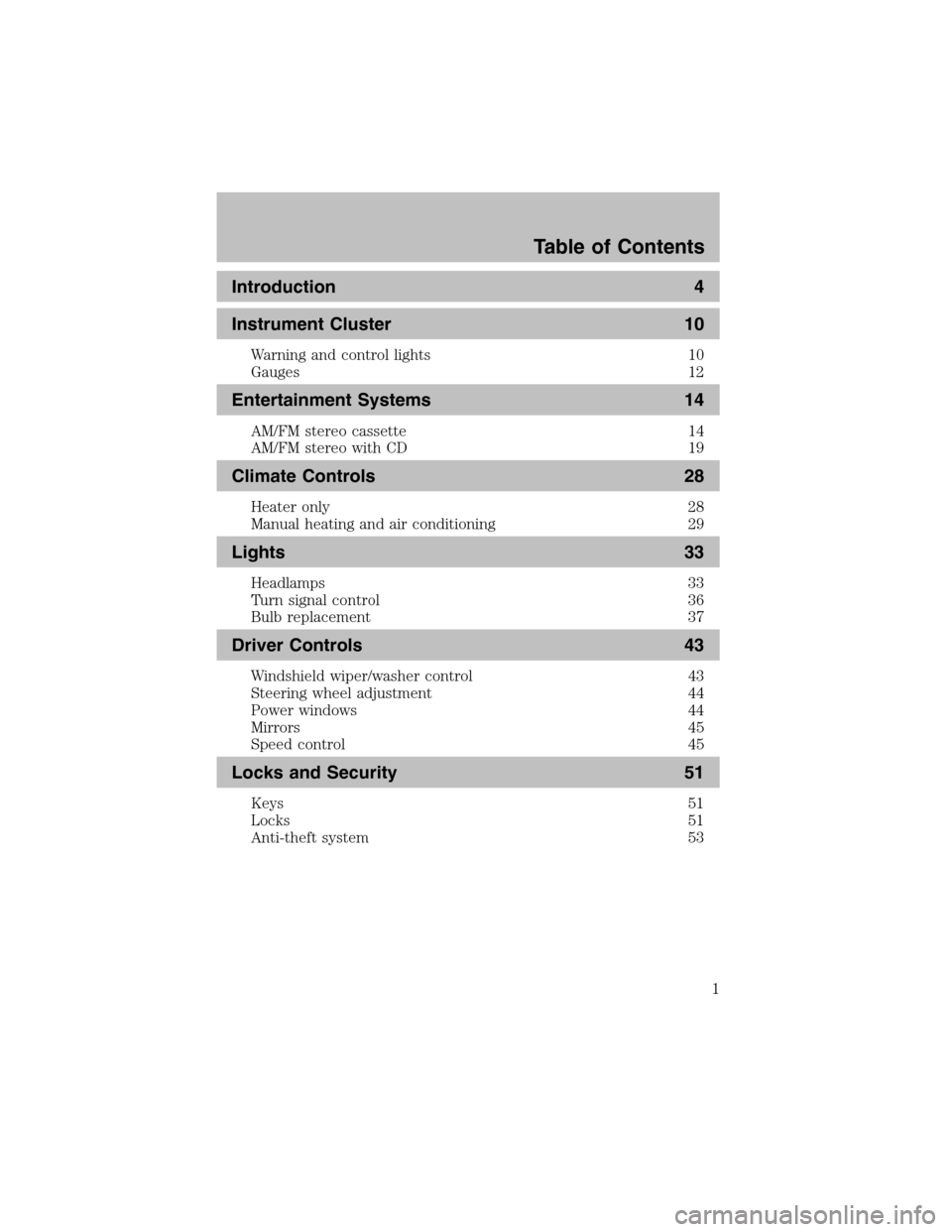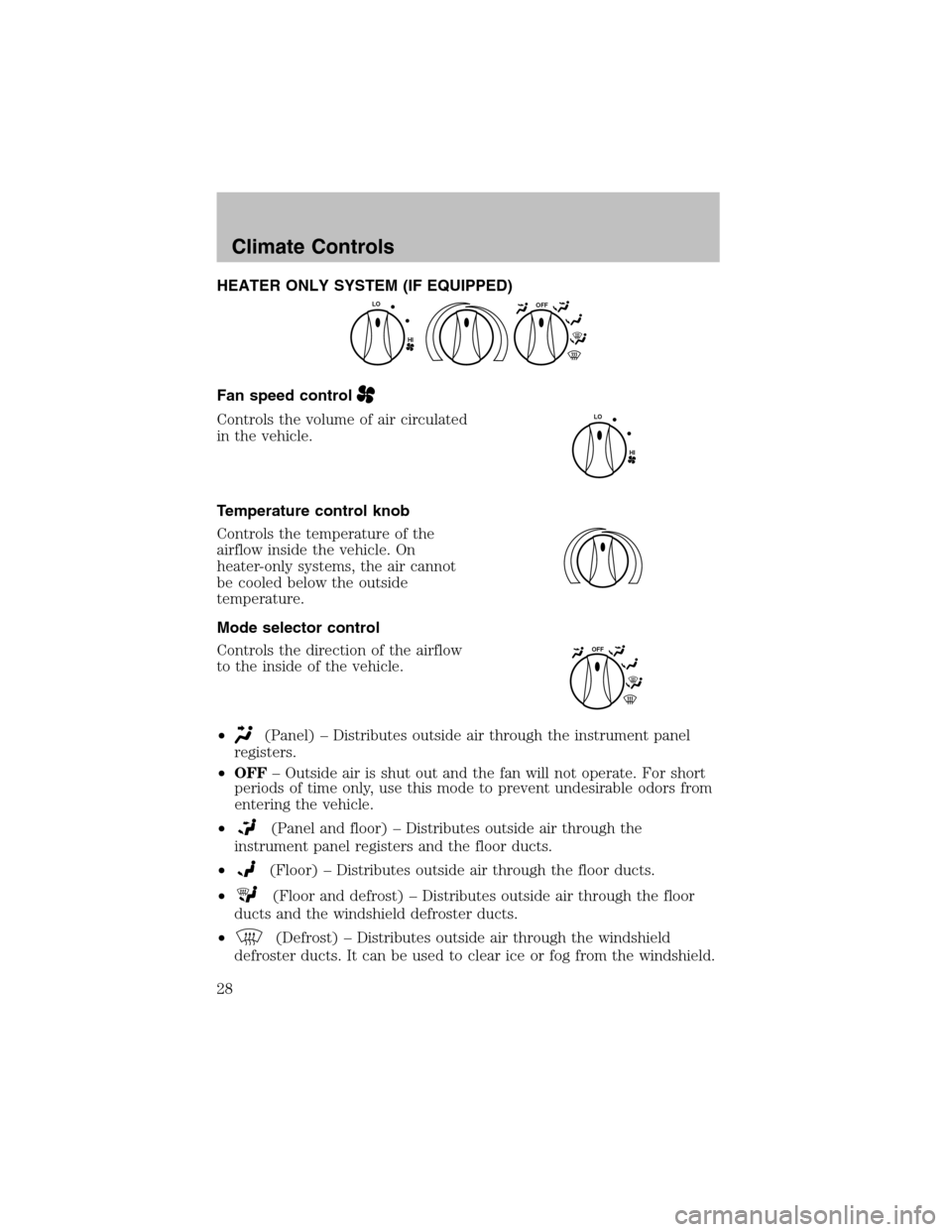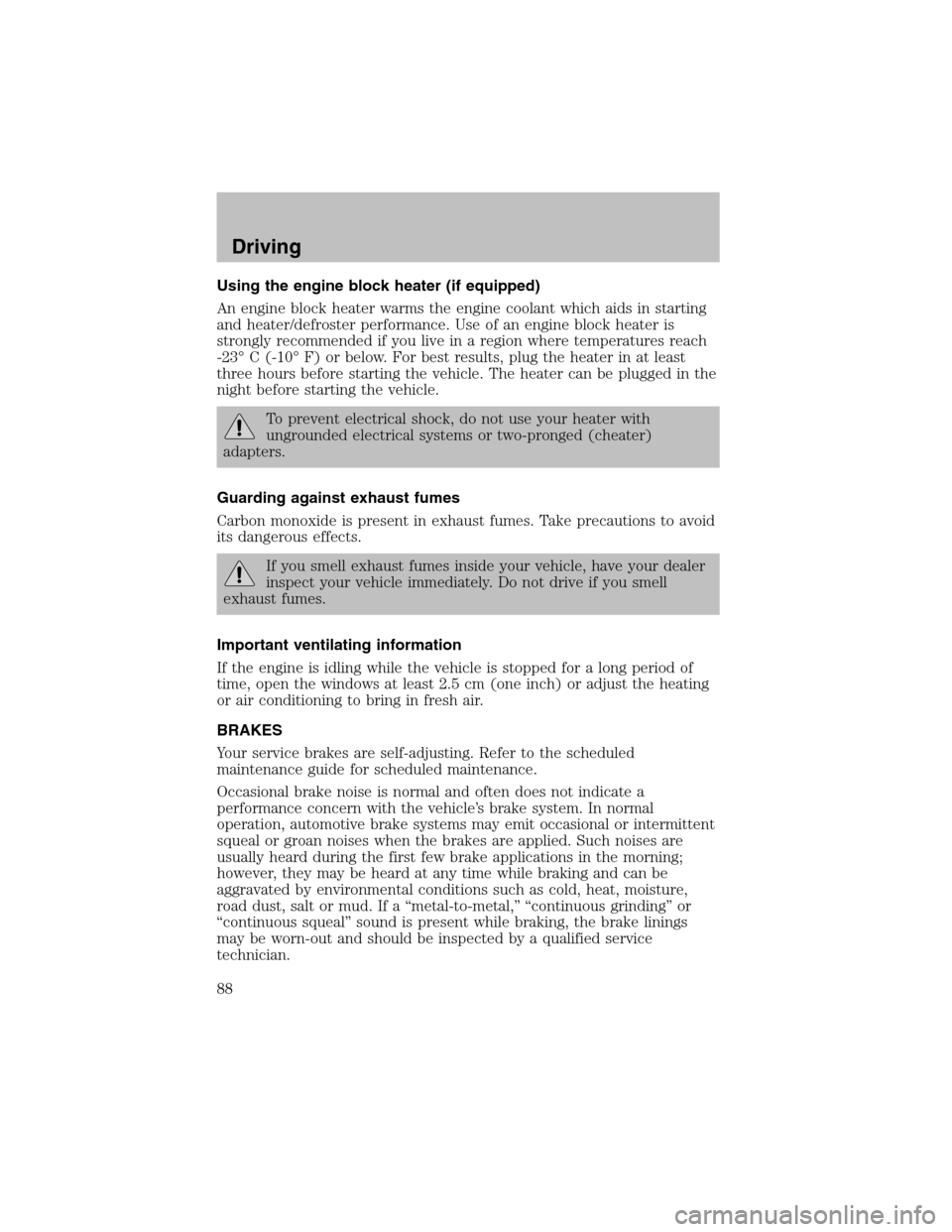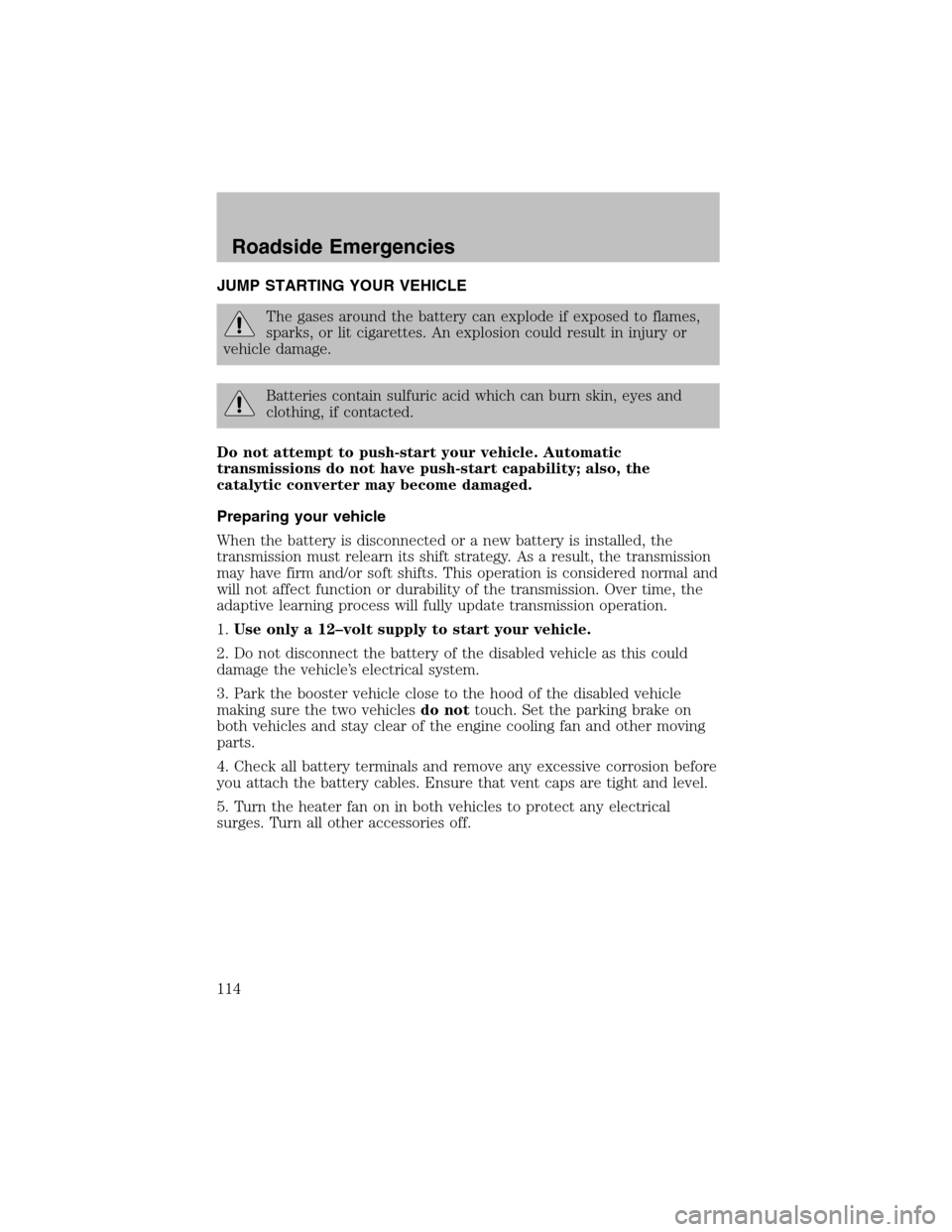2003 FORD ESCORT heater
[x] Cancel search: heaterPage 1 of 184

Introduction 4
Instrument Cluster 10
Warning and control lights 10
Gauges 12
Entertainment Systems 14
AM/FM stereo cassette 14
AM/FM stereo with CD 19
Climate Controls 28
Heater only 28
Manual heating and air conditioning 29
Lights 33
Headlamps 33
Turn signal control 36
Bulb replacement 37
Driver Controls 43
Windshield wiper/washer control 43
Steering wheel adjustment 44
Power windows 44
Mirrors 45
Speed control 45
Locks and Security 51
Keys 51
Locks 51
Anti-theft system53
Table of Contents
1
Page 28 of 184

HEATER ONLY SYSTEM (IF EQUIPPED)
Fan speed control
Controls the volume of air circulated
in the vehicle.
Temperature control knob
Controls the temperature of the
airflow inside the vehicle. On
heater-only systems, the air cannot
be cooled below the outside
temperature.
Mode selector control
Controls the direction of the airflow
to the inside of the vehicle.
•
(Panel) – Distributes outside air through the instrument panel
registers.
•OFF– Outside air is shut out and the fan will not operate. For short
periods of time only, use this mode to prevent undesirable odors from
entering the vehicle.
•
(Panel and floor) – Distributes outside air through the
instrument panel registers and the floor ducts.
•
(Floor) – Distributes outside air through the floor ducts.
•
(Floor and defrost) – Distributes outside air through the floor
ducts and the windshield defroster ducts.
•
(Defrost) – Distributes outside air through the windshield
defroster ducts. It can be used to clear ice or fog fromthe windshield.
OFF
HI
LO
HI
LO
OFF
Climate Controls
28
Page 88 of 184

Using the engine block heater (if equipped)
An engine block heater warms the engine coolant which aids in starting
and heater/defroster performance. Use of an engine block heater is
strongly recommended if you live in a region where temperatures reach
-23° C (-10° F) or below. For best results, plug the heater in at least
three hours before starting the vehicle. The heater can be plugged in the
night before starting the vehicle.
To prevent electrical shock, do not use your heater with
ungrounded electrical systems or two-pronged (cheater)
adapters.
Guarding against exhaust fumes
Carbon monoxide is present in exhaust fumes. Take precautions to avoid
its dangerous effects.
If you smell exhaust fumes inside your vehicle, have your dealer
inspect your vehicle immediately. Do not drive if you smell
exhaust fumes.
Important ventilating information
If the engine is idling while the vehicle is stopped for a long period of
time, open the windows at least 2.5 cm (one inch) or adjust the heating
or air conditioning to bring in fresh air.
BRAKES
Your service brakes are self-adjusting. Refer to the scheduled
maintenance guide for scheduled maintenance.
Occasional brake noise is normal and often does not indicate a
performance concern with the vehicle’s brake system. In normal
operation, automotive brake systems may emit occasional or intermittent
squeal or groan noises when the brakes are applied. Such noises are
usually heard during the first few brake applications in the morning;
however, they may be heard at any time while braking and can be
aggravated by environmental conditions such as cold, heat, moisture,
road dust, salt or mud. If a “metal-to-metal,” “continuous grinding” or
“continuous squeal” sound is present while braking, the brake linings
may be worn-out and should be inspected by a qualified service
technician.
Driving
88
Page 107 of 184

Passenger compartment fuse panel
The fuses are coded as follows:
Fuse/Relay
LocationFuse Amp
RatingPassenger Compartment Fuse
Panel Description
DRL 10A Daytime Running Lamps (DRL)
HAZARD 15A Hazard flasher
ROOM 10A Engine controls, RAP system,
Radio, Shift lock, Courtesy lamps,
Starting system, Warning chime,
Instrument cluster
ENGINE 15A Electronic automatic transaxle,
Ignition system, Constant control
relay module (PCM relay)
RADIO 5A Power mirrors, Radio, RAP system
DOOR LOCK 30A Power door locks
HORN 15A Horn, Shift lock
AIR COND 15A A/C-heater, ABS
METER 10A Backup lamps, Engine coolant
level switch, Instrument cluster,
Rear window defrost, Shift lock,
Warning chime, Turn signal switch
(DRL) (DOOR LK)
STOP
HAZARD HORN
TAIL
ROOM(AIR COND) (SUN ROOF)
ENGINE METER(ASC)
RADIO
WIPER
–P. Window (C.B.)
(FOG) CIGAR
(AUDIO)
AIR BAGFUEL INJ
HEATER
–
Roadside Emergencies
107
Page 114 of 184

JUMP STARTING YOUR VEHICLE
The gases around the battery can explode if exposed to flames,
sparks, or lit cigarettes. An explosion could result in injury or
vehicle damage.
Batteries contain sulfuric acid which can burn skin, eyes and
clothing, if contacted.
Do not attempt to push-start your vehicle. Automatic
transmissions do not have push-start capability; also, the
catalytic converter may become damaged.
Preparing your vehicle
When the battery is disconnected or a new battery is installed, the
transmission must relearn its shift strategy. As a result, the transmission
may have firm and/or soft shifts. This operation is considered normal and
will not affect function or durability of the transmission. Over time, the
adaptive learning process will fully update transmission operation.
1.Use only a 12–volt supply to start your vehicle.
2. Do not disconnect the battery of the disabled vehicle as this could
damage the vehicle’s electrical system.
3. Park the booster vehicle close to the hood of the disabled vehicle
making sure the two vehiclesdo nottouch. Set the parking brake on
both vehicles and stay clear of the engine cooling fan and other moving
parts.
4. Check all battery terminals and remove any excessive corrosion before
you attach the battery cables. Ensure that vent caps are tight and level.
5. Turn the heater fan on in both vehicles to protect any electrical
surges. Turn all other accessories off.
Roadside Emergencies
114
Page 176 of 184

FORD ACCESSORIES FOR YOUR VEHICLE
A wide selection of genuine Ford accessories are available for your
vehicle through your local authorized Ford, Lincoln, Mercury or Ford of
Canada dealer. These quality accessories have been specifically
engineered to fulfill your automotive needs; they are custom designed to
complement the style and aerodynamic appearance of your vehicle. In
addition, each accessory is made from high quality materials and meets
or exceeds Ford’s rigorous engineering and safety specifications. Ford
Motor Company will repair or replace any properly dealer-installed Ford
accessory found to be defective in factory-supplied materials or
workmanship during the warranty period, as well as any component
damaged by the defective accessory. The accessory will be warranted for
whichever provides you the greatest benefit:
•12 months or 20,000 km (12,000 miles) (whichever occurs first), or
•the remainder of your new vehicle limited warranty.
This means that genuine Ford accessories purchased along with your
new vehicle and installed by the dealer are covered for the full length of
your New Vehicle’s Limited Warranty — 3 years or 60,000 km (36,000
miles) (whichever occurs first). Contact your dealer for details and a
copy of the warranty.
Not all accessories are available for all models.
Vehicle Security
Remote keyless entry
Wheel locks
Vehicle security systems
Comfort and convenience
Cargo net
Cargo organizer
Engine block heater
Remote start system
Smoker’s package
Accessories
176
Page 180 of 184

Climate control (see Air
conditioning or Heating) ......28–29
Clock ......................................17, 25
Clutch
fluid ..................................160–161
operation while driving ............97
recommended shift speeds ......98
Coolant
checking and adding ..............146
refill capacities ................150, 170
specifications ..................171–172
Cruise control
(see Speed control) ....................45
Customer Assistance ................103
Ford accessories for your
vehicle .....................................134
Ford Extended Service
Plan ..........................................120
Getting assistance outside
the U.S. and Canada ..............126
Getting roadside assistance ...103
Getting the service you
need .........................................120
Ordering additional owner’s
literature .................................127
The Dispute Settlement
Board .......................................123
Utilizing the
Mediation/Arbitration
Program...................................126
D
Defrost
rear window ..............................32
Dipstick
automatic transmission
fluid ..........................................161
engine oil .................................141Doors
lubricant specifications ..........171
Driving under special
conditions ....................................96
through water ...........................98
E
Emergencies, roadside
jump-starting ..........................114
Emission control system ..........158
Engine ........................................172
cleaning ...................................131
coolant .....................................146
idle speed control ...................144
lubrication
specifications ..................171–172
refill capacities ........................170
service points ..........................140
starting after a collision .........104
Engine block heater ...................88
Engine oil ..................................141
checking and adding ..............141
dipstick ....................................141
filter, specifications ........143, 169
recommendations ...................143
refill capacities ........................170
specifications ..................171–172
Exhaust fumes ............................88
F
Floor mats ...................................50
Fluid capacities .........................170
Foglamps .....................................33
Fuel ............................................151
calculating fuel economy .......155
cap ...........................................153
capacity ...................................170
Index
180
Page 181 of 184

choosing the right fuel ...........153
comparisons with EPA fuel
economy estimates .................158
detergent in fuel .....................155
filling your vehicle with
fuel ...........................151, 153, 155
filter, specifications ........155, 169
fuel pump shut-off switch .....104
improving fuel economy ........155
octane rating ...................154, 172
quality ......................................154
running out of fuel .................155
safety information relating to
automotive fuels .....................151
Fuses ..................................105, 107
G
Gas cap (see Fuel cap) ............153
Gas mileage
(see Fuel economy) .................155
Gauges .........................................12
GAWR (Gross Axle Weight
Rating) .........................................99
definition ...................................99
driving with a heavy load ........99
location ......................................99
GVWR (Gross Vehicle Weight
Rating) .........................................99
calculating .................................99
definition ...................................99
driving with a heavy load ........99
location ......................................99
H
Hazard flashers .........................104
Head restraints ...........................58
Headlamps ...................................33
aiming ..................................34–36bulb specifications ....................37
flash to pass ..............................34
high beam.................................33
replacing bulbs .........................38
turning on and off ....................33
Heating
heater only system...................28
heating and air conditioning
system.......................................29
Hood ..........................................138
I
Ignition .................................84, 172
Infant seats (see Safety seats) ..76
Inspection/maintenance (I/M)
testing ........................................159
Instrument panel
cleaning ...................................133
cluster ........................................10
lighting up panel and
interior .......................................34
J
Jack ............................................110
positioning ...............................110
storage .....................................110
Jump-starting your vehicle ......114
K
Keys
positions of the ignition ...........84
L
Lamps
bulb replacement
specifications chart ..................37
Index
181